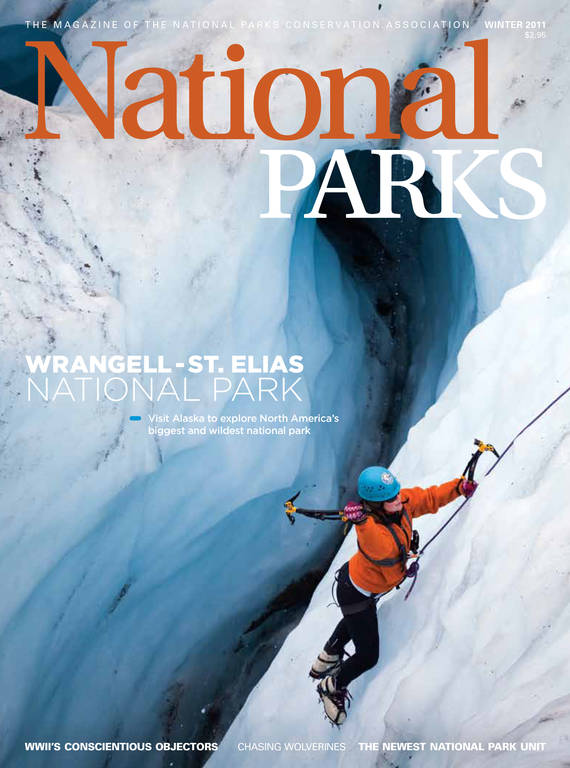Winter 2011
Arching Forward
The Park Service embraces a new vision for the Jefferson National Expansion Memorial in St. Louis.
As you approach St. Louis, Missouri, your eye is drawn to a gleaming silver structure looming in the distance, pulling you toward the city center—the iconic stainless-steel curve anchors the Jefferson National Expansion Memorial. But after checking your map, dialing up the GPS, and craning your neck as you pass a dozen exit ramps, you start to wonder if maybe you just can’t get there from here.
The sculptural marvel more commonly referred to as “The Gateway Arch” was designed by Architect Eero Saarinen and completed in October 1965. The park, designed by renowned landscape architect Dan Kiley, reflects the city’s role in America’s westward expansion and serves as a memorial to Thomas Jefferson and the pioneers who explored the untamed landscape that would eventually come under our flag. The 630-foot Arch and surrounding park are situated on a 90-acre plot of land on the shores of the Mississippi River, but a spaghetti-bowl of highways surrounds the site, cutting off connections from every angle. To get there, you’ve got to dodge dozen of vehicles as you cross six lanes of traffic on foot, enter through a parking garage, or walk in from the park’s desolate southern edge. And once you arrive, you realize the best way to experience it may have been from that highway exit ramp back in Illinois. Visitors who want to ride the tram to the top of the Arch must wait in a security line, purchase tickets, then be trapped inside an outdated museum for several hours, until their number is called. Few would compare the experience to that offered up by other urban parks like Washington’s National Mall or San Francisco’s Golden Gate National Recreation Area.
“The arch itself is an extraordinary piece of public sculpture and an engineering marvel that takes the concepts of Western migration, optimism, courage, and discovery and wraps them into a phenomenal piece of art—but it’s isolated,” says Walter Metcalfe Jr., one of the founders of the CityArchRiver 2015 Foundation. “Its themes focus on connections, moving forward, and coming together, yet it’s located on an exquisite island surrounded by an interstate, a set of railroad tracks, and a river set away from the Arch itself. The area is so foreboding and uninviting that people can’t wait to get there, take a photograph, and get out of town.”
“The Arch is beautiful, but it’s in a passive park that is in dire need of relevancy,” says Lynn McClure, director of NPCA’s Midwest regional office and another founder of CityArchRiver. “It’s in a thriving city but disconnected from everything—as far as the ‘potentialometer’ for parks, the potential is huge. People who live and work downtown see a raw canvas and want to know how to leverage this attraction for the city of St. Louis.”
Forty-five years after the memorial’s construction, that’s finally happening. In December 2009, CityArchRiver invited landscape architects from around the world to participate in a competition to reenvision the visitor experience for the hundreds of thousands of people who make the journey every year. The goal was not to just construct a new visitor center or erect additional structures to populate the landscape, but to reshape the entire experience in a way that invites visitors to explore the area and stay longer, and to bring more meaning to the experience for locals, who only visit the Arch with their out-of-town guests. In September, the panel of judges selected Michael Van Valkenburgh Associates (MVVA) of New York City to tackle the challenge. The firm designed Brooklyn Bridge Park and took inspiration from other waterfront parks including Millennium Park in Chicago and Allegheny Riverfront Park in Pittsburgh, and it’s now working with the Park Service, the City of St. Louis, and a host of other adjacent landowners to refine some initial design concepts and make them a reality. MVVA will present its final project design, budget, and implementation plan this January; the project is to be finished by October 2015, the 50th anniversary of the Arch’s completion.

National Parks
You can read this and other stories about history, nature, culture, art, conservation, travel, science and more in National Parks magazine. Your tax-deductible membership donation of $25 or more entitles…
See more ›The new plan would make ticketing available throughout the grounds, so visitors could roam outside the museum, if they prefer. Skylights would let light into the underground museum. A performance stage on the river would host outdoor concerts or film screenings in warmer months. Restaurants and vendors would be encouraged to open concessions on the edge of the historic landscape, just beyond the park boundary, to invite more visitors to linger. And across the Mississippi River, in Illinois, a contaminated area would be transformed into a sprawling riverfront park, literally expanding the memorial dedicated to expansion. Congress has empowered the Park Service to acquire the land across the river—the move will require additional funding, but planners believe it’s a goal that’s well within reach.
“The most important part of this vision is the fact that it’s led by landscape architecture, not a physical structure,” says Metcalfe. “It’s bringing the city and the river and the Illinois side together, giving people reasons to linger in the space, not just as a matter of physical comfort but as a tool to engage people in a public space.”
“The Arch could become a model for urban national parks,” says McClure. “The park simply wants to tell its story in the best way to attract the most people, and the city wants to attract more people as well, so the interests here are perfectly aligned.”



